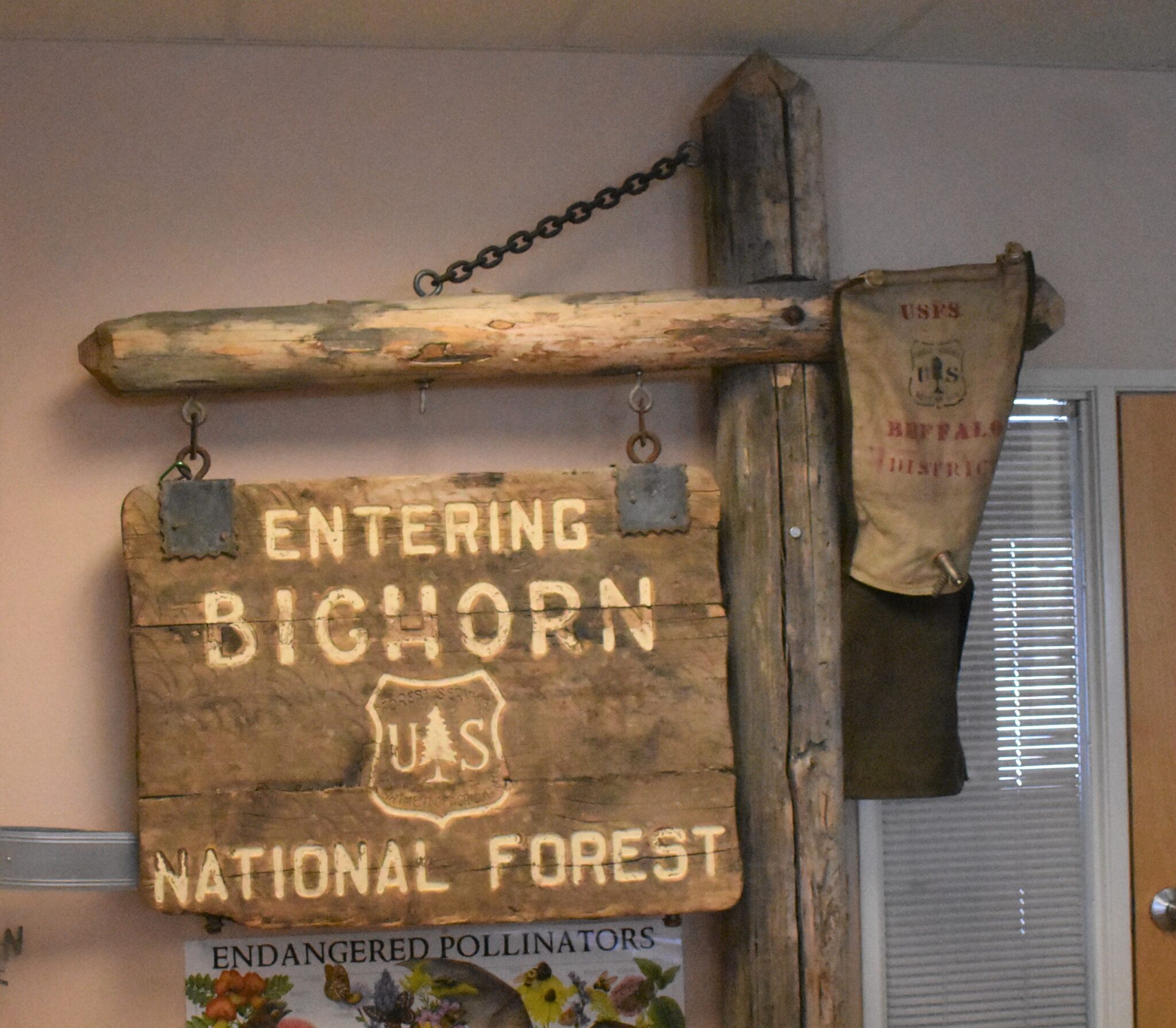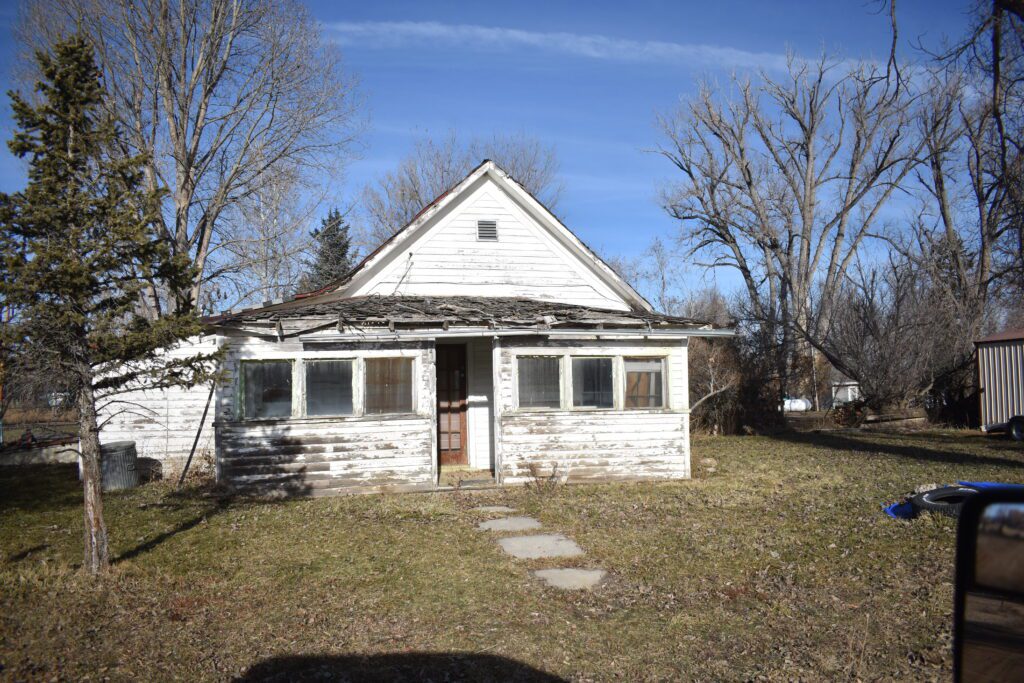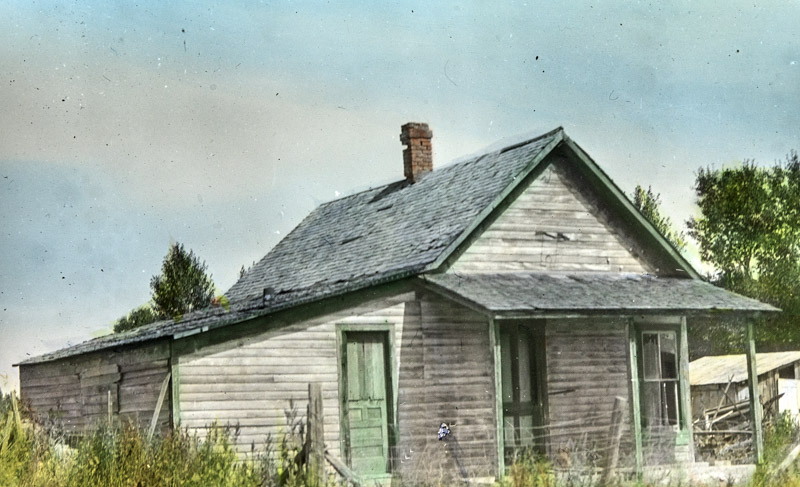News
History: W.E. Jackson, Forest Supervisor

There is a small frame house in Big Horn, Wyoming at the corner of Third and High Street. It is in disrepair now, but it has an interesting history that Craig Cope, Buffalo, feels should be preserved. Cope has worked for the forest service for many years and now is a volunteer at the Jim Gatchell Memorial Museum in Buffalo, working with Sylvia Bruner, museum director, on the Big Horn National Forest collection. The museum received the collection of photos and documents in the fall of 2020.

Cope said he found one interesting item in the documents.
According to the old newspapers, he was supervisor as early as 1899. Cope said that many of the rangers and supervisors kept journals, Jackson did not.
The Peoples Voice, May 1, 1897

This sketch about W.E. Jackson appeared in the Sheridan Post, Supplement, September 30, 1903 – The subject of this sketch is one of the old timers and most influential men of the Sheridan country, he was member of the first regularly-elected board of commissioners of Johnson county, and also of Sheridan county, helping to put the government of both counties on its feet. In the old county he was under-sheriff, and also road overseer, when he covered what is now Johnson and Sheridan counties, and that was perhaps the most important office in Johnson counts. In 1895 he represented Sheridan county in the state legislature, in highly creditable manner. He has held his present position, that of supervisor of the Big Horn Forest reserve, the past five years, and is making an excellent officer, Mr. Jackson growed (sp) the first fruit matured in Wyoming, He displayed some apples at the county fair at Big Horn in 1883, and received diploma from the state.
Hon. W. E. Jackson was born in Shelby county, Indiana, March 7th, 1843. He came to Wyoming in 1880 from lowa. His wife was Miss Amanda Davies of Hawleyville, lowa. Two girls and son were born to them, one of the daughters is now Mrs. I. Martin of Big Horn, while the other is the wife of Dr W. B. Carver of Denver. The son, C. F. Jackson, is prosperous ranch man of this section, being interested in stock with his father. The senior Jackson has 380 acres of rich land at Big Horn. Of this 240 acres are watered, and he has nice home and a fine orchard.
Whether the house mentioned is the one that is still handing is not known at this time, but it is possible.

A colorized photo of the house, taken in 1920. Courtesy Jim Gatchell Memorial Museum and Slyvia Bruner
The job of the forest supervisor was managing the forest, and directing a staff to discover and fight forest fires, as well as managing the timber sales and grazing rights.
The Wyoming Industrial Journal, December 1, 1899 – Guarding The Forests. C. W. Garbutt of Sheridan, Wyoming, superintendent of the Government forest reserves of Wyoming and South Dakota, with Supervisor Jackson of the Big Horn Reserve and number of forest rangers, was in attendance upon the United States Court here few days ago to secure the punishment of trespassers and violators of the reserve regulations.
During the year Mr. Garbutt has had under him force of fourteen rangers for the Black Hills Reserve, thirteen for the Big Horn, six for the Yellowstone and eight for the Teton. The rangers have patrolled the extensive forests of these reserves, put out forest fires, cut new trails, cleared up brush and fallen timber and worked generally to improve and preserve the forests.
During the year they have put out over 100 fires, many of which might have proved very destructive. Nearly all of these fires originated with campers, who carelessly left their camp-fires burning. One big fire was experienced during the year which burned over several townships. This was on Tongue River and started in the Big Horn Mountains, off the reserve. The entire force of rangers for the Big Horn Reserve fought the fire and with the aid of ranchmen and stockmen succeeded in extinguishing it, but not until great damage had been done.
Mr. Garbutt received during the year authority to permit sheep-owners to range their sheep on the southern half of the Big Horn Reserve. Permits were issued for 150,500 sheep to enter the reserve, but not more than 25,000 have been placed on the reserve so far. The forest superintendent has orders from the Department of the Interior to note carefully the effect of sheep-grazing on the reserve, and it is intended to determine by actual observation whether or not the grazing of sheep materially damages the forests.
Since the establishment of the reserves over 31,000,000 feet of timber have been sold from the Black Hills Reserve, under the direction of the Government officers. Prior to the establishment of the reserves this class of timber was taken without any payment being made to the Government. The receipts for timber sold have amounted to as much as the cost of maintaining these reserves, to say nothing of the value of timber saved by preventing the spread of fires.
The areas of the reserves in Wyoming and South Dakota under the jurisdiction of Mr. Garbutt are as follows: Black Hills Reserve, 1,166,080 acres in South Dakota and 45,500 inWyoming; the Teton, 829,440 acres; the Yellowstone, 1,239,040 acres, and the Big Horn, 1,127,680 acres, total of 4,407,840 acres.
The Sheridan Post, August 17, 1899

Forest fires were frequent in the reserve, later renamed the Bighorn National Forest. This from The Sheridan Post, August 20, 1909
Fire in the mountains about 50 miles, northwest of Sheridan threatens destruction to valuable timber and consequent loss to considerable other property in that section. W. E. Jackson, supervisor of the Big Horn Forest reserve, received word Wednesday that a blaze was in progress there and that, every effort was being made to cope with the unpleasant situation.
Details are lacking as to the manner in which the fire started, but it is supposed the dry weather conditions proved an easy prey to even a spark from some camp blaze, The early reports indicated that the fire, originating at the headwaters of Devils canon near the line of the forest reserve and the Crow Indian reservation, was running down the canon and destroying heavy timber. It has since been learned that a force of fifteen or twenty men have been working night and day to subdue the flames, with excellent prospects of winning over the fire demon. The greatest danger reported was the possibility of a stiff breeze developing and fanning the flames. The men engaged in the work are putting forth heroic efforts to put out the fire.
And this from the Basin Republican, August 5, 1910 – Forest Fires Frequent. The hazy condition of the atmosphere which has obtained for a week or more and which has become more marked the past few days, is occasioned by forest fires In Montana and Idaho. W. E. Jackson, forest supervisor of the Big Horn mountains and with headquarters in Sheridan, has organized systematic line of telephonic communication. Telephone wires have been strung through the mountains and rangers have been stationed at intervals with instructions to give the first warnings and take preliminary steps to put down any fire that starts. Suspicious fires have been noted in Missoula where the animals have been forced to leave the forests. Other points in Montana and in Idaho are being scourged by the fire demon.
The mention of telephone wires in the above article was also in part due to W.E. Jackson while he was supervisor.
From the Wyoming Tribune (Cheyenne), July 17, 1906 – Phone Line Big Horn Forest Reserve Being Connected up by System 109 Miles in Length. The Government Starts Work on First of Telephone Systems on Forest Reserve — Will Facilitate the Handing of Forest Fires and Other Business. Special to The Tribune. – Sheridan, July 17 Superintendent W.E. Jackson of the Big Horn Forest reserve, west of here, announces that work has just been commenced on the construction of a telephone system which will connect up all parts of the reserve. This is the first of the telephone systems to be constructed by the government on all of its forest reserves for the purposes of facilitating the administration of the affairs of the reserve in fighting fires and for other objectives.
The system on the Big Horn reserve will be 109 miles in length and will be installed at a cost of $5,000. It will connect up all portions of the reserve and will be connected with the Rocky Mountain Bell Telephone company’s lines at Ten Sleep, in order to give the reserve officials communication with Washington and the outside world.
Jackson was also in charge of hiring rangers for his district. This from The Daily Enterprise, April 28, 1910 –Forest Service ! Good Class Took Examination Last Week Before Supervisor Jackson. Eleven applicants took the examination for the national forest service, at Big Horn, at the office of Supervisor Jackson, of the Big Horn Forest reserve. A number of other applicants did not report for the examination, thereby missing an opportunity that was well worth the time and expense.
The subject of the national forests is one of considerable importance and every possible courtesy was extended to the class by Mr. Jackson and the rangers present, and duly appreciated.
W.E. Jackson was one man who did a lot to help establish the Bighorn National Forest that we know today, and his house still stands in Big Horn, Wyoming.


Michael Dykhorst
January 20, 2024 at 2:11 pm
My Great Great Great Uncle!
Michael Dykhorst
January 21, 2024 at 10:14 pm
My great great great uncle. Also the headline says W.F Jackson. It should be changed to W.E Jackson